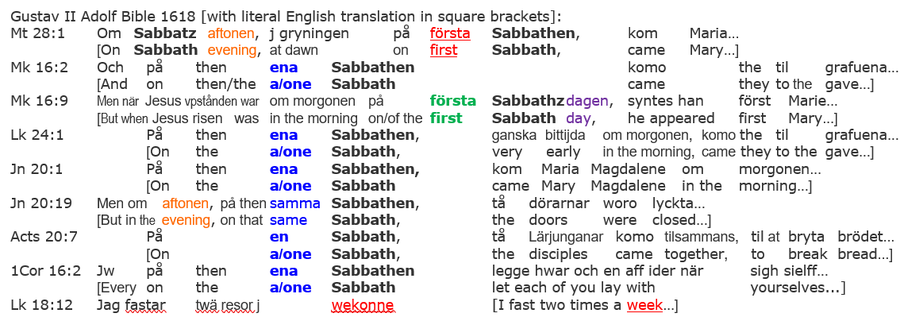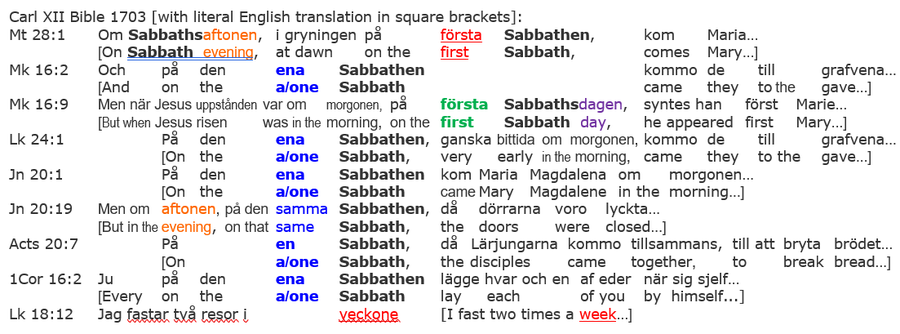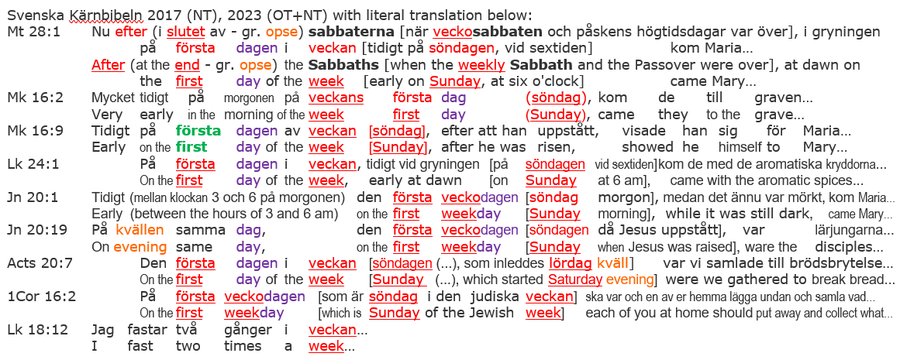- Home
- English
- Structure of the Bible
- Structure of the Menorah
- Ancient Menorahs
- Calendar and Feasts
- Resurrection on Sabbath
- Introduction
- Day
- Sabbath
- High Sabbath
- Pre-Sabbath
- Week
- Interlinear Bible
- Church Opinions
- 1. No Sunday
- 2. A Sabbath
- 3. No Friday
- 4. Intermediate Day
- 5. Three Days and Three Nights
- 6. Manipulations
- 6.1 Sabbath not Sunday
- 6.2 Plural σαββατων not week
- 6.3 one not first
- 6.5 Day of the Sabbaths
- 6.7 Lords Day
- 7. Old Bibles
- Greek Bibles
- Latin Bibles
- Gothic Bible
- English Manuscripts
- English Bible Prints 1
- English Bible Prints 2
- English Bible Prints 3
- English Bible Prints 4
- German Manuscripts
- German Bible Prints 1
- German Bible Prints 2
- Spanish Bibles
- Italian Bibles
- Swedish Bibles
- μια των σαββατων
- Mt 28-1
- Mk 16-2
- Mk 16-9
- Lk 24-1
- John 20-1
- John 20-19
- Acts 20-7
- 1Cor 16-2
- Lk 18-12
- 7 Languages
- Palm Sabbath
- Omer
- Summary
- The Rapture
- Rabbi Kaduri Note
- 666
- 888
- Video
- Info
- Francais
- Deutsch
- Espanol
- Dutch
- Ελληνική
- Pусский
- Introduction
- Day
- Sabbath
- High Sabbath
- Pre-Sabbath
- Week
- Interlinear Bible
- Church Opinions
- 1. No Sunday
- 2. A Sabbath
- 3. No Friday
- 4. Intermediate Day
- 5. Three Days and Three Nights
- 6. Manipulations
- 6.1 Sabbath not Sunday
- 6.2 Plural σαββατων not week
- 6.3 one not first
- 6.5 Day of the Sabbaths
- 6.7 Lords Day
- 7. Old Bibles
- Greek Bibles
- Latin Bibles
- Gothic Bible
- English Manuscripts
- English Bible Prints 1
- English Bible Prints 2
- English Bible Prints 3
- English Bible Prints 4
- German Manuscripts
- German Bible Prints 1
- German Bible Prints 2
- Spanish Bibles
- Italian Bibles
- Swedish Bibles
- μια των σαββατων
- Mt 28-1
- Mk 16-2
- Mk 16-9
- Lk 24-1
- John 20-1
- John 20-19
- Acts 20-7
- 1Cor 16-2
- Lk 18-12
- 7 Languages
- Palm Sabbath
- Omer
- Summary
Swedish Bibles show the Sabbath Resurrection of Jesus
In the first Swedish Bibles, which were officially examined and published by Kings and by the official Church, the resurrection of Jesus „on a Sabbath“ remained astonishingly clear for about 500 years. Only from 1917 onward, the day on which Jesus rose from the dead was deliberately postponed. So if today the Sabbath resurrection of Jesus is taught, this is not the opinion of a sect, but the opinion of kings and churches, which was officially proclaimed over many centuries. The translation of the Swedish Bibles in particular is very easy to understand and leaves no room for interpretation. It is always only about the resurrection „on a Sabbath day“. This is the content of the first Swedish Bibles, while only the most recent ones teach the unbiblical Sunday.
Gustav Wasa Bible 1526 (NT) & 1541 (OT+NT)
The Swedish king Gustav I. Vasa (*1496, †1560; Wikipedia) gave the order to create the first Swedish Bible (Wikipedia, Facsimiles). „At the Västerås Diet in 1527, Gustav I. Vasa - instead of the Pope - was appointed head of the Swedish Church“ (Wikipedia). The reformers Olaus Petri, Laurentius Andreae (Lars Anderson; *1470, †1552) and Laurentius Petri, who was appointed Sweden's first Protestant archbishop, participated in the Bible studies. The basic text was the Vulgate and the basic Greek text (as far as it was available) and later also the Luther translation of 1526. The printer was Jürgen Richolff, who was called to Sweden from Northern Germany in 1539. The NT was already published in Uppsala in 1526 (Facsimiles) and the whole Bible in 1541, which was the only Swedish Bible until 1917. In the meantime, the text has only been slightly revised twice and was published as the Gustav II Adolf Bible 1618 and the Carl-XII Bible 1703. The first edition of 1526 is particularly interesting, as it was excellently translated and even speaks of the coming of women to the tomb „on a Sabbath day“ (ena sabbatz daghen) in Mt 28:1, contrary to the Vulgate, which mentions the „first Sabbath". Mk 16:9 rightly refers to the „first Sabbath“. But only those who were familiar with the calendar of God could know that this refers to the first of the seven weekly Sabbaths up to Pentecost. In this sensational (and officially approved by several Swedish kings) Bible, the resurrection of Jesus has been correctly translated in all places. Jesus was resurrected „on a Sabbath day" (på en sabbatz daghen), „on a Sabbath“ (på ena Sabbathen), „on the first Sabbath day“ (på första Sabbatz daghen). And the church met „on a Sabbath“ (på en Sabbatz) or „on a Sabbath day“ (på en Sabbatz daghen). And Jesus appeared to the disciples on „the same sabbath“ (samma Sabbathen; Jn 20:19). Every little child understands this. There was never any mention of a Good Friday - Easter Sunday tradition in this King's Bible, because Jesus was not resurrected on the day of the sun-god Sol (Sunday), but already on the day before, namely on his day, the Sabbath. The translator was a great expert in languages and therefore expressly renounced the word week (wikwn, wekonne; cf. Lk 18:12); he knew what he was saying and what he was not saying. The text of the NT from 1526 and 1541 follows:

Gustav II Bible 1618
The Gustav II Adolf Bible (Wikipedia, facsimiles) was published in 1618 during
the reign of king Gustav II Adolf (Gustavus Adolphus; *1594; †1632; Wikipedia) and was a slightly modified version of the Gustav Vasa Bible 1541 (facsimiles). The church did not want any
changes, so the text of the 1541 Bible was adopted almost in its entirety. The textual changes between 1526 (NT) and 1541 (complete Bible) were much greater than the spelling improvements in the
1618 Bible. In addition, new illustrations and verse numbers were added. It was the second Swedish Bible. It still included the resurrection of Jesus „on a Sabbath morning“. The kings/rulers who
followed Gustav II Adolf also issued new Bibles to confirm their power "by the grace of God". But all their printings were merely copies of the Reformation Bible of 1541, such as the
Queen Christina Bible 1646 (facsimiles), Charles X Gustav Bible 1655 (facsimiles) and the Charles XI
Bible 1674 (facsimiles).
As the text of the Gustav Vasa Bible was only slightly altered in all modern editions, later reprints (with verse counts) were also known colloquially as "Gustav Vasa Bibles".
The facts in our context are: For centuries, all these Swedish kings propagated the teaching in their official church Bibles that women came to the grave „on a Sabbath“ (ena Sabbathen) and on the „first Sabbath day“ (första Sabbatzdagen). There was never any mention of an alleged "Sunday" or „first day of the week“ or „after the Sabbath“:

Carl-XII Bible 1703
With the consent of King Charles XII of Sweden (Karl XII; *1682, †1718; Wikipedia), a new version of the Gustav Vasa Bible was published in 1703 in an improved language (Wikipedia; facsimiles). The same text was reprinted in London in 1828 and 1873, among others, and in Stockholm in 1853. The Carl XII Bible was the official Swedish Church Bible until 1917, i.e. for 200 years, and was even reprinted in 2009/2010. Both in the edition of 1703 and in many later printed versions, the Resurrection Sabbath has been preserved. The statements are so clear that they could not be clearer. These words are understood by every child in Sweden. The third King's Bible also says that Jesus rose from the dead „on a Sabbath morning“. And Jesus appeared to the disciples „on the same Sabbath“ (den samma Sabbathen). This was also the day on which the disciples met, namely NOT „on a Sunday“ and NOT „on the first day of the week“, but „on a Sabbath“ (en Sabbath). Are there any questions left?

Svensk Bibel (Swedish Bible) 1800-1917
As already mentioned, there was the Carl-XII-Bible in Sweden (facsimiles), which was reprinted again and again in current language and simply called "Swedish Bible" (Svensk Bible, facsimiles). The NT ("Nya Testamentet") was not only produced in Sweden, but also in London and in the USA many times. While the Bibles printed abroad contained the same text from 1703, only the spelling has changed in the Bibles printed in Stockholm. But the Sabbath on which Jesus rose from the dead was not questioned for such a long time and was a biblical part of the official church Bible:

A bilingual version was published in New York in 1865 by the American Bible Society. While the Swedish text speaks of the resurrection of Jesus „on a Sabbath“ (ena Sabbathen), the English version reports of the „first day of the week“. Thus many Christians were confused, because God does not contradict himself in two languages, but the theologians.
Bibelkomissionen NT 18xx
At the end of the 18th century, a Bible commission was set up with the task of revising the previous Swedish Bibles. There were 10 test translations and proposals (facsimiles). In the process, the resurrection Sabbath was increasingly removed from the Bible and replaced by the „first day of the week“ (första dagen i weckan). This work took a total of 144 years until the official Church Bible of 1917 was published. Until then, the Bible of Charles XII (with the Sabbath resurrection of Jesus) was still officially in use. Some of these attempts are:

1917 Church Bible - 1917 års kyrkobibel - Svenska Bibelöversättning 1917
In the German and Swedish languages the resurrection of Jesus „on a Sabbath“ and „on the first Sabbath“ (the first of the 7 Sabbaths between Passover and Pentecost) lasted for several centuries. This only changed in 1917 when the new official Swedish Bible („Bibeln eller den Heliga Skrift“) came out, which was also called the Gustav V. Bible or „1917 års kyrkobibel“ (1917 Church Bible; facsimiles). In this edition the evangelists' statement was falsified and the resurrection of Jesus was simply postponed by one day. For this purpose the theologians dramatically removed the biblical Sabbath in all places and replaced it with the expression „på första veckodagen“ („on the first weekday“):

Levande Bibeln 1974 (NT) or Nya Levande Bibeln 2003
The new translation from the English (New Living Bible) is even freer (facsimiles and online Bible). It is an interpretation and not a translation. In Mt 28:1, Mk 16:2,9; Lk 24:1, John 20:1 it speaks of „söndagsmorgonen“ („Sunday morning“), in Acts 20,7 and 1Cor 16,2 of söndag (Sunday). In John 20:19 there is no further mention of which day it is. These are completely different statements from those in the first Swedish Bibles. Are there two days where everyone can choose one? No, the Greek basic text, the Latin Vulgate and all the first Swedish Bibles show the resurrection of Jesus "on a Sabbath morning". But this Bible makes it a Sunday morning, because that is a church invention to equate the Christian feast days with the pagan feast days:

Svenska Folkbibeln (Swedish Folk Bible) 1998
The Swedish Folk Bible (Abbr.: SvFolk or SFB, facsimiles) is a well-established translation. But even it did not adhere to the basic Greek text in the chapter on the resurrection. This edition was published in 1998 and the NT was revised again in 2014. So an event that took place „on a Sabbath“ (as the earlier Swedish Bibles clearly show) was postponed to the day after:

Bibel 2000
This modern translation in clear Swedish was intended to reach as many people as possible. Work began in 1972, the NT was published nine years later and the OT was completed in 2000, so the name Bible 2000 was chosen (Facsimiles/online Bible). We can only hope that as few people as possible read it and prefer to open the old Swedish Bibles, which are much more accurate and speak of the women coming to the grave „on a Sabbath“ and not „efter sabbaten“ (after the Sabbath). Anyone who adds the word after (efter) to the Bible is committing a very serious mistake (a sin) and automatically deceives many Christians:

Svenska Kärnbibeln 2017 (NT), 2023 (OT+NT)
Svenska Kärnbibeln (Facsimiles and Online Text) is a non-profit Swedish translation project for the Bible. The translation is expanded, which means that some words are translated with several Swedish words between square brackets and explanations are inserted directly into the text between square brackets. In the resurrection chapter, the result is shocking, because here the unbiblical Sunday (söndag) has been added to the Word of God several times. The poor readers no longer hear anything about the biblical Sabbath, which was in all Swedish Bibles for several centuries, but instead only about the „first day of the week“ (första dagen i veckan) and see such silly comments as „this is the Sunday of the Jewish week“ (som är söndag i den judiska veckan), which is completely wrong, since the pagan Sunday begins at midnight, but every biblical day begins at sunset. Since the translators do not know God's calendar, they therefore cannot know that the evangelists only ever meant the first Sabbath (Mk 16:9), i.e. the first of the 7 Sabbaths between Passover and Pentecost, which is found in every biblical and Jewish calendar. But most Christians only know the Pope's non-biblical 4 Advent Sundays, so they do not understand the statements of the basic Greek text. This is the sad result:

Conclusion
The first Swedish Bibles are excellent and they speak in clear words that every small child understands that Jesus rose from the dead "on a Sabbath morning". Easter Sunday was only introduced into the Swedish Bibles centuries later. Question: Has God changed his mind over the centuries or have theologians changed and distorted the Word of God to find their beloved Sunday in the Bible?
The Bible clearly describes what will happen to people who delete something from God's Word and replace it with something else, thereby deceiving God's children.
Numerous Bibles in many languages show the resurrection of Jesus on a Sabbath morning:
7. Many old Bibles proclaim the resurrection of Jesus on a Sabbath or Saturday morning
7.1 Greek Bibles show the Sabbath resurrection
7.2 Latin Bibles show the Sabbath resurrection
7.3 Gothic Bibles show the Sabbath resurrection
7.4.1 German Bible manuscripts show the Sabbath resurrection
7.4.2 German Bible prints 1 (before Luther) show the Sabbath resurrection
7.4.3 German Bible prints 2 (since Luther) show the Sabbath resurrection
7.4.4 German Bible prints 3 (since 1600 to 1899) show the Sabbath resurrection
7.4.5 German Bible prints 4 (since 1900) show the Sabbath resurrection
7.5.1 English Bible manuscripts show the Sabbath resurrection
7.5.2 English Bible prints 1 (from 1526 to 1799) show the Sabbath resurrection
7.5.3 English Bible prints 2 (from 1800 to 1945) show the Sabbath resurrection
7.5.4 English Bible prints 3 (from 1946 to 2002) show the Sabbath resurrection
7.5.5 English Bible prints 4 (from 2003) show the Sabbath resurrection
7.6 Spanish Bibles show the Sabbath resurrection
7.7 French Bibles show the Sabbath resurrection
7.8 Swedish Bibles show the Sabbath resurrection
7.9 Czech Bibles show the Sabbath resurrection
7.10 Italian Bibles show the Sabbath resurrection
7.11 Dutch Bibles show the Sabbath resurrection
7.12 Slovenian Bibles show the Sabbath resurrection
"Prove all things; hold fast that which is good. Abstain from all appearance of evil"
(1Thess 5:21-22)
"Take no part in the unfruitful works of darkness, but instead expose them"
(Epheser 5:11)